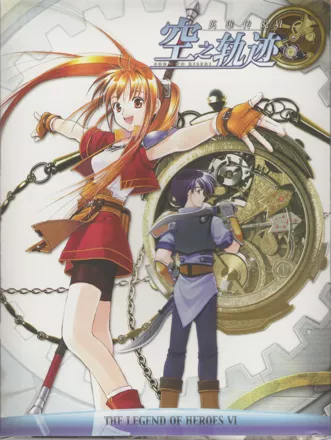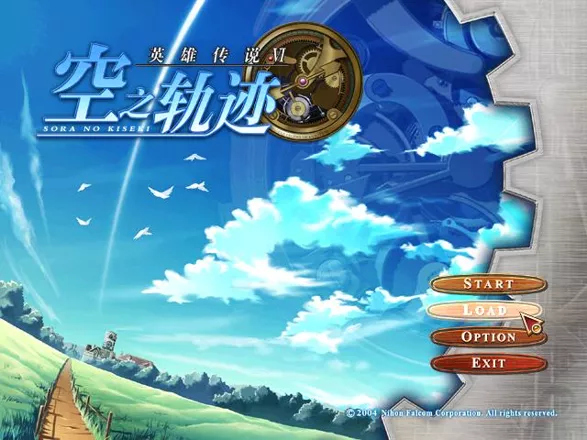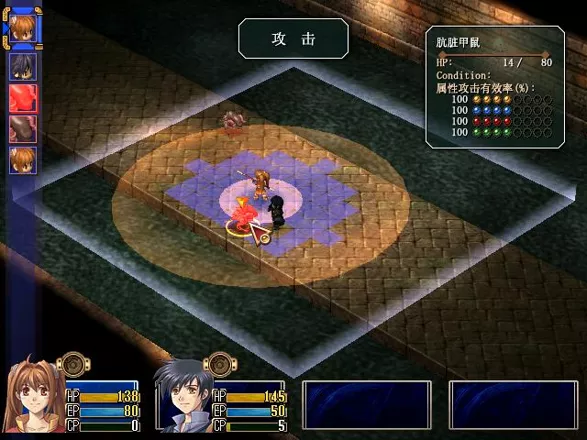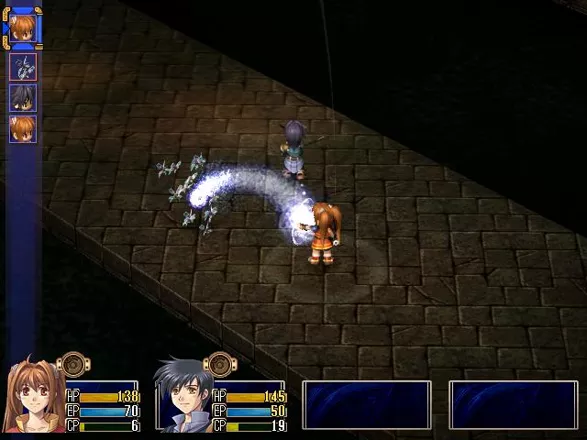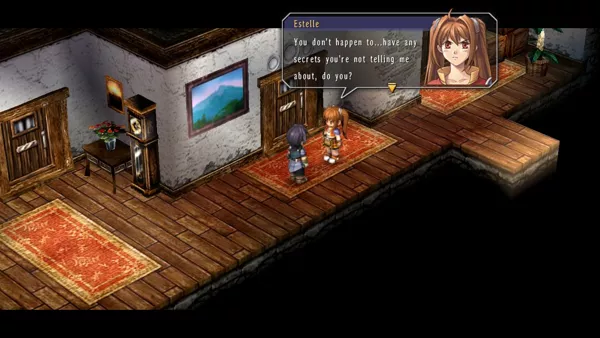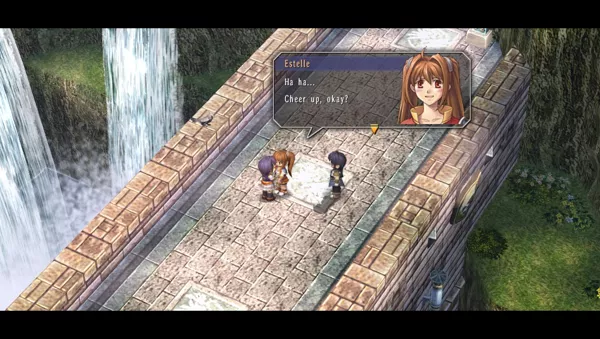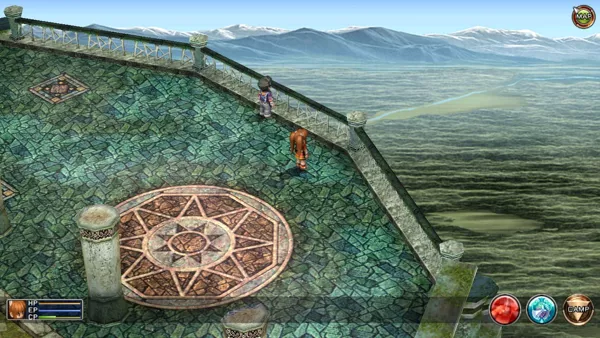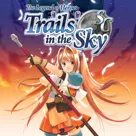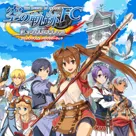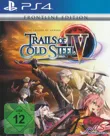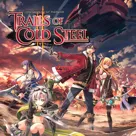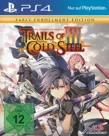The Legend of Heroes: Trails in the Sky
Description official description
In this latest installment of the long-running Legend of Heroes series, you control two heroes: Estelle bright, a daughter of the famous adventurer Cassius, and her adopted brother Joshua, who was brought to live in their house under mysterious circumstances. The family belongs to an adventurer guild called "bracers", who protect town people and do various dangerous tasks for money. When Cassius leaves to another town, Estelle and Joshua have to perform various missions as the bracers, and soon find themselves in a middle of a sinister conspiracy!
Although released for the PC, this is a Japanese console-style RPG with turn-based combat. You can move your party member over the battle screen and perform various attacks, including the so-called "Arts" (special attacks) and "Crafts" (similar to limit breaks in Final Fantasy games). There are also many story-related and optional bracer missions to do that will increase your rank in your profession.
Spellings
- 英雄传说VI: 空之轨迹 - Chinese spelling (simplified)
Groups +
Screenshots
Promos
Credits (Windows version)
54 People (48 developers, 6 thanks) · View all
| Programmers | |
| Graphic Artists | |
| Scenario Writers - Event Script Editors | |
| Music Composers / Sound Team jdk | |
| Theme Song "Hoshi No Arika" |
|
| [ full credits ] | |
Reviews
Critics
Average score: 82% (based on 17 ratings)
Players
Average score: 4.0 out of 5 (based on 11 ratings with 1 reviews)
The Good
* A lengthy, compelling adventure in a cohesive world. And it's only the beginning!
-
Combat can be rewarding against tough enemies and bosses, and the game demands you utilize every system it has.
-
Excellent soundtrack
The Bad
* Combat and exploration become a grindy and tedious process, especially near the end game as enemies get stronger. -
Dated visuals for its era
-
UI needs some adjustments, particularly when retrying encounters.
The Bottom Line
When naming some of Japan’s developers which specialize in RPGs, a few names typically come to mind: Square Enix, Atlus, even Monolith Soft. Yet one very long-running company that rarely gets talked about is Nihon Falcom. For whatever reason, Falcom has produced games for decades that usually fall under the radar in the West, not helped by often sluggish localization processes. They are best known for two long-running series: the Ys series, and The Legend of Heroes series.Trails in the Sky is the sixth installment of the latter series, but it is also the first installment of a subseries called “Trails”. These particular games take place in the same universe in different countries of a fantasy world that’s in the throes of an industrial revolution, and the events which happen in one game will be referenced in future games down the line. Though set in a world ripe with epic adventure, the games are driven more by interpersonal and political drama as tensions between its various nations boil and simmer. This isn’t something like Final Fantasy where you can just jump in on any game, these games are highly interconnected, and form one large, cohesive story that has been told over the last 16 years. That makes getting into this series an incredibly daunting task for newcomers. And it all began with this game.
Trails in the Sky is the first of what has come to be known as the “Liberl Arc” of the Trails series, beginning with this game and continuing with two more sequels. The storyline centers on a young warrior named Estelle Bright, the daughter of the top-ranked Bracer named Cassius. Estelle spent about half of her life living with her adopted brother Joshua, who was brought home one day under mysterious circumstances. Years later, Estelle and Joshua set out on a year-long quest to become Bracers, or freelance knights, just like their father and guardian Cassius, but soon discover a much more sinister plot happening in the shadows after their father mysteriously vanishes while on a secret mission.
Following the main story will take you through the five regions of the country of Liberl, which is situated in a loop consisting of the five main cities linked together by roadways that branch off into smaller towns and various dungeons. Estelle and Joshua are expected to visit each of the regions as part of their Bracer training, and the game’s five acts take place in each of these regions. Once you finish a region, you aren’t allowed to travel back to it. During each act, your party will team up with one of several different party members, up to a maximum of four, each with their own skills, weapons, personalities, and backstories.
Trails is notorious for the sheer amount of text that each game has, and this first installment is definitely no exception. You’ll spend just as much time in cutscenes reading dialogue and talking to NPCs as you will battling monsters and collecting loot. Every NPC has multiple lines of dialogue which change following various story events, and they react to the actions you achieve while on your quests. Characters from earlier chapters, both playable and non-playable can and often will show up unexpectedly in later ones, making the world feel cohesive and connected. There is also a lot of lore you can learn about in the world, from its man religion to its history up to the point where its at now.
Each chapter will also have their own quests to complete at that region’s Bracer Guild. These can range from simple quests to kill tough monsters to more involved tasks which take place over several different quests. Doing these quests is by far the best way to earn gold, which you can then spend on healing items or upgrading your party’s weapons, armor, and accessories, which are necessary to survive tough boss battles. Just be sure to turn them all in to the Bracer Guild when you’ve completed them!
You can also purchase meals at restaurants, and when these are eaten your party members will gain various buffs and learn their recipes. Afterwards, these can be crafted in the field using ingredients that you find or purchase from shops. It becomes downright essential to have a diverse and lengthy cookbook of recipes on hand, as these foods are often superior and cheaper than the healing items which you can buy from shops. After all, Estelle and Joshua are travellers on a journey, and sampling all of the local cuisine is just part of that experience.
Combat in Trails in the Sky is turn based and utilizes a hybrid system of a traditional JRPG with light elements from tactical RPGs. You can see enemies which appear in the world and sneaking up on them from behind will give you a first-turn advantage. Each battle takes place on an isometric grid, and you can move, use items, and attack enemies depending on your character’s position. Each character also has special skills to use: arts and crafts. Crafts can be utilized in the same turn and are unique to each character, while arts, which are essentially this game’s form of magic, can be used by any character but take time to cast. The type of arts each character can use is determined by how their orbments have been set up (more on that later). Certain enemies are more susceptible to specific elemental arts, and you can use this to your advantage during the early game to quickly destroy foes, though by the end game most enemies don’t have any particular elemental weaknesses. The main wrinkle in all of this is that every character operates on a timed turn system. There are various bonuses which appear alongside the turn order, and you’ll need to use spells and attacks to manipulate the turn order to ensure that these bonuses land on your character’s turns rather than the enemies’. You’ll also need to take advantage of the numerous status effects such as petrify, confuse, faint, and sleep, which also take turns away from enemies. Most of these only have a chance to hit, and different enemies are resistant to certain effects, so you can’t rely on them too much, but finding the right one to use can certainly make a difference in battle. I found that equipping each party member to inflict these effects on an attack was far more efficient than attempting to do the same with using arts. Just don’t let them happen to your party members!
Arts and Crafts use the EP (effort points) and CP (craft points) gauges respectively, and while the EP gauge is filled using certain items or resting, CP are built up when characters attack, get hit, or use arts. When the CP gauge reaches 100, the character can utilize an S-Craft, a special attack which usually deals massive, massive damage but depletes the CP gauge entirely. Using an S-Craft when the CP gauge is at the maximum level (200) unleashes a stronger version of the S-Craft. Once available, these S-Crafts can also be used at any time as S-Breaks even if your character’s turn is not up yet, allowing you a chance to disrupt your enemies and turn the tides of battle in your favor.
Then there’s the orbment system. All of the technology and magic in the world of Trails is powered by orbal energy, and your party members carry pocketwatch-like devices called orbments in order to utilize the benefits of this energy. You can slot various quartz orbs into each party member’s orbments to grant them stat boosts and the ability to utilize various arts. You can use the sepith, or orbal materials you harvest from enemies to open more orbment slots or buy stronger quartz orbs to use in your current slots. I initially randomly placed quartz into slots without thinking about their placement, but later in the game I realized that placing quartz in a certain way will allow characters to utilize both stronger and area-of-effect arts, which are crucial to surviving the tougher battles. This system is similar to other progression systems like the Final Fantasy VII materia system, so if you’ve played games like that you’ll understand how this works even if the terminology is a bit weird..
While this system is enjoyable once you wrap your head around exactly how everything works, there are a few things which can serve as frustrations along the way. First, most battles that feature a high amount of enemies to fight can be incredibly frustrating, as your party will need to tank several hits before they can take their turn. Trails in the Sky is very forgiving when it comes to running away from battles, as all but a few story-specific battles can be fled from if you feel your party is getting overpowered. However, things got to a point where unless there were only one or two enemies in a battle, I felt better off avoiding it until I got my hands on the best gear and weapons available, as the sheer tedium and frustration of these larger-scale battles would take away from the exploration and the desire to get to the next story beat. I would also use this tactic to help train my party’s CP up to max level, then unleashing all of my S-Breaks at the start of a boss battle.
I played the game on hard mode, and at every turn I felt like the game was practically begging me to get my hands on the best gear and weapons upgrades available for each of my party members, and to battle every monster chest to ensure I was getting all of the rewards for an easier time in the boss battles. In other words, playing on hard mode made the game more tedious, and while I appreciated that it actually forced me to explore everywhere and consider using every last one of the game’s numerous systems to my advantage, it also made me grind and grind like few games do these days. I think I must have spent about 10 hours in the final dungeon alone getting all of the monster chests, as each encounter required serious preparation just to come in swinging with the best attacks. Making things worse is that despite a generous save system that lets you save at any time, there is no way to just reload a game after dying in battle to tweak your party’s orbment and accessory loadouts, which can mean the difference between victory and defeat. You will have to quit to the main menu and hope that either you or the game saved before the battle you are stuck on. On the plus side, you can retry encounters at an easier difficulty should you feel you have no other way of getting through the battle, though this can be turned off in the game’s settings.
One reason that Falcom is perhaps not as revered as other developers I mentioned is due to their games’ often outdated visual appearance. Trails in the Sky came out exclusively on PC in 2004, right at the height of the PS2 era, yet visually it more closely resembles PS1 or Sega Saturn-era RPGs. The game primarily uses a combination of 3D world geometry with 2D pre-rendered character and enemy sprites drawn from multiple directions. The textures and sprites are fairly low-res, although the UI elements such as text and character portraits scale pretty nicely with the widescreen resolution. This graphics style was too dated to be considered cutting-edge yet not dated enough to be considered retro-cool, so the visuals fall into the trap of being underwhelming in the context of the release. Generally, the world of Trails in the Sky consists of more detailed town and dungeon areas connected by various roads, which despite having different lighting and textures, more often than not tend to look rather samey. There are a could of high-up areas which use skyboxes, and some of these don’t scale properly to the resolution, resulting in ugly black stripes on the sides of my screen. Thankfully, the towns do look pretty nice, and interiors are decently realized even if many of them pull from a lot of the same assets. I’m also like how expressive the character portraits are, and how their faces tend to change the more they get wounded. Despite some appealing elements here and there, this is not a game you’ll be playing for the graphics.
In terms of sound design, Trails in the Sky offers a distinctively retro experience. The sound effects are punchy and anime-flavored, while the soundtrack is filled with the kinds of pan flute-filled digital melodies one might expect from a game like this. While there is voice acting, it’s limited to grunts and lines after battle: otherwise, the game is entirely text-based.
Though this is a game from 2004, it travelled a long, long road before finally seeing the light of day in the Western PC market. This game was ported to the Sony PSP in Japan in 2006, and it was this version which was initially localized and released in the West in 2011 by XSEED games. Three years later, a localized Windows port was finally released, marking a decade after the original. This version features controller support, support for high-resolutions, and most importantly, turbo mode. By holding down a trigger, you can speed up the game, which greatly cuts down on the wait time for various attacks and makes exploration much faster and simpler.
Trails in the Sky was an exhausting and at times frustrating experience, but it definitely had that something that kept me going. There’s a reason that games like this rarely get made anymore. Maybe it was the relief of finally getting past a tricky boss battle and the satisfaction of exploring every possible area of Liberl that I could. Maybe it was getting to see this new world along with the characters for the first time. Maybe it was the music. Or maybe it was knowing that despite its epic length this was only a very small part of what lies ahead for me as I dive into this lesser-known series. By the time I reached the game’s ending at nearly 60 hours of play time, I felt both incredibly fulfilled yet yearning to see what the next chapter has in store. Trails in the Sky may ultimately be an opening act, but it puts on quite a show if you can stick with its quirks.
Windows · by krisko6 (814) · 2020
Analytics
Upgrade to MobyPro to view research rankings!
Identifiers +
Contribute
Are you familiar with this game? Help document and preserve this entry in video game history! If your contribution is approved, you will earn points and be credited as a contributor.
Contributors to this Entry
Game added by Unicorn Lynx.
PSP added by jj984jj.
Additional contributors: MAT.
Game added December 20, 2004. Last modified March 24, 2024.
